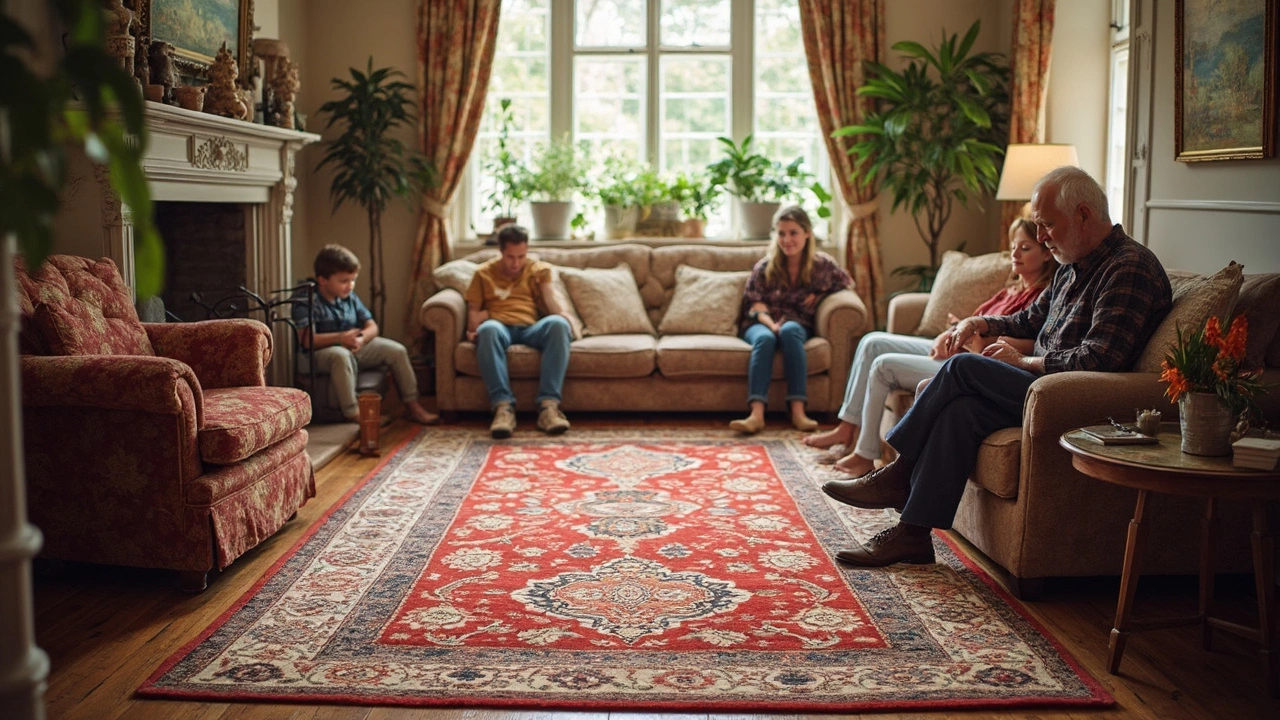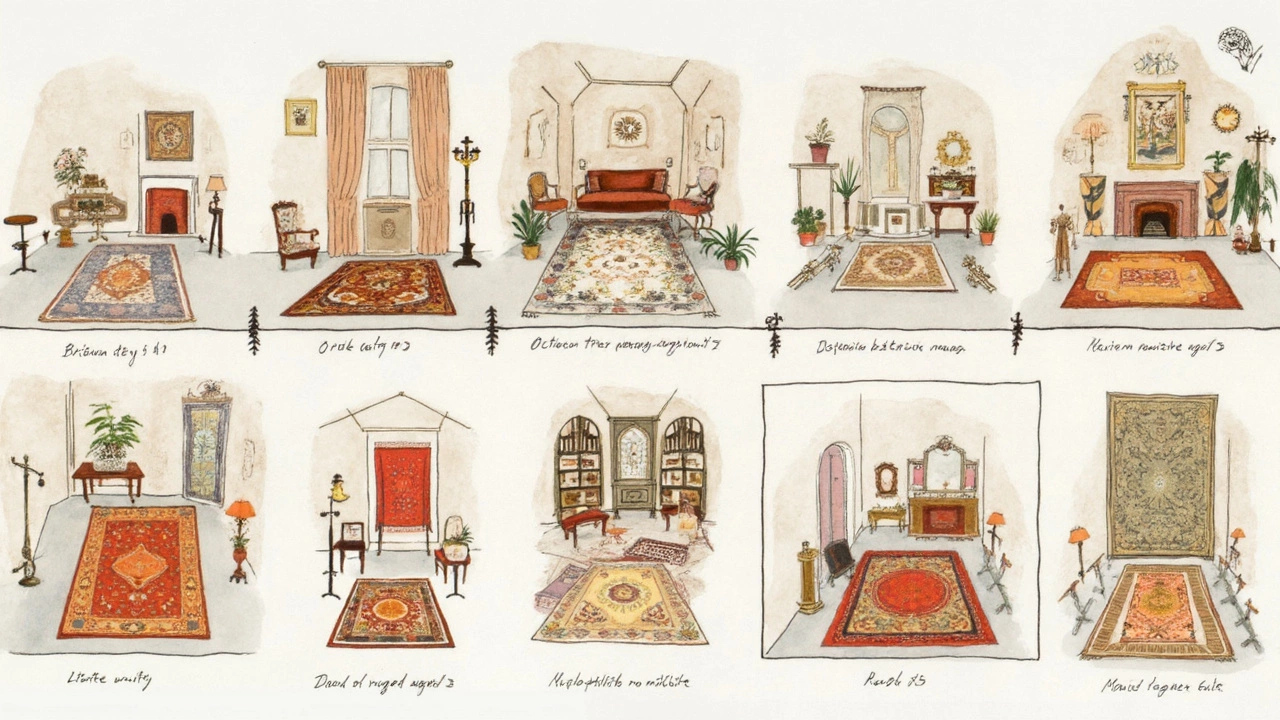Rugs: What Does the Word Really Mean and Why Should You Care?
 Apr, 24 2025
Apr, 24 2025
If you hear the word 'rugs' and instantly think of something soft under your feet, you aren’t wrong—but that’s just scratching the surface. People throw the word around all the time, but few actually know there’s more to rugs than just being mats or fancy patches of fabric tossed on the floor. A rug is basically a textile floor covering, smaller than a carpet, and usually not fixed to the floor. You can move it, clean it, fold it, or even use it as a piece of art. Simple, right?
But here’s where things get a bit messier: a lot of folks mix up rugs and carpets. The main difference? Rugs are smaller, not wall-to-wall, and they’re almost always portable. You won’t need a crew or power tools if you decide it’s time for a change.
If you’re browsing for a quick update to your living room or a way to keep your toes warm in the morning, knowing what a rug actually is (and isn’t) can save you time and stress. Once you get the idea, you’ll see rugs aren’t just about looks—they can totally transform the vibe of a room. Next time you’re eyeing that rolled-up textile in a store, you’ll know exactly what you’re dealing with.
- What Does 'Rugs' Mean Anyway?
- Rugs vs. Carpets: Not the Same Thing
- A Bit of Rug History That Might Surprise You
- Top Tips for Choosing and Using Rugs at Home
What Does 'Rugs' Mean Anyway?
Let’s cut through the confusion: when people talk about rugs, they’re talking about a thick, woven piece of fabric specifically meant for the floor. Unlike a carpet (which is usually fixed and covers the entire flooring), a rug is loose, movable, and comes in an almost endless range of sizes and shapes. So, yes, that little fuzzy rectangle under your coffee table? It’s a rug, not a carpet.
Usually, rugs are made from materials like wool, cotton, jute, silk, synthetic fibers (think polyester and nylon), or a blend. This matters, because different fibers offer different levels of softness, durability, and ease of cleaning. Wool rugs, for example, absorb dirt well and feel cozy underfoot, while synthetic ones are known for being stain-resistant and budget-friendly. If you’re allergy-prone, cotton and natural fiber rugs tend to trap less dust than shaggier versions.
You’ll spot rugs everywhere: entryways, kitchens, bedrooms, and offices. Besides covering floors, they can visually break up a space, provide warmth, and add color and texture. Some people even hang them on walls as art—nobody said rugs have to stay on the floor!
If you’re curious about how rugs are sized up compared to other floor coverings, check this out:
| Type | Typical Width | Typical Placement |
|---|---|---|
| Rug | 2 to 9 feet | Movable, usually for smaller areas |
| Carpet | Wall-to-wall | Permanently installed |
| Runner | 2 to 3 feet wide | Hallways or stairs |
One last thing—when you hear “rug,” there’s no single style it has to fit. Persian, shag, flatweave, hooked, braided—you name it. If it covers some floor space and you can move it, it’s a rug!
Rugs vs. Carpets: Not the Same Thing
This mix-up happens all the time—people call a rug a carpet or the other way around. But when you know what separates a rug from a carpet, shopping (and talking about your floors) gets a lot less confusing.
The biggest difference is size and how they’re installed. Rugs are usually much smaller than carpets. Rugs are loose, portable, and can be picked up and moved somewhere else, no special tools needed. Carpets? They’re the wall-to-wall stuff that gets nailed or glued down by professionals, covering your whole floor in one go.
Check out this quick breakdown:
| Feature | Rug | Carpet |
|---|---|---|
| Size | Small/Medium | Large, wall-to-wall |
| Portability | Can be moved easily | Fixed in place |
| Installation | No installation needed | Requires professional fitting |
| Cleaning | Just pick up and shake out or wash | Usually needs special equipment |
| Use | Add style, warmth, or color to a spot | Background coverage for whole room |
Another thing: Rugs can sit on top of carpets. Sounds odd, but it’s actually a popular design move to add a burst of color or texture, especially in living rooms and bedrooms. Try that with carpet-on-carpet—yeah, it doesn’t really work!
If you’re looking for something that adds a quick splash of style without redoing your whole floor, go for a rug. Want a permanent, all-over floor covering? Carpet’s your answer. Next time you’re out shopping, you’ll know exactly what to ask for—no more guessing in the home aisle.

A Bit of Rug History That Might Surprise You
When most people think of rugs, they picture modern homes or a trip to IKEA. But here’s a fun fact: rugs have been part of human life for thousands of years. The oldest surviving rug, called the Pazyryk rug, is about 2,400 years old and was found frozen in a Siberian tomb. It’s wild to think that even back then, people cared about comfort and style underfoot.
Way before rugs landed in living rooms, they were huge in nomadic cultures. People who moved around a lot couldn’t have installed carpets, so they made portable rug coverings for warmth and decoration. In places like Persia (now Iran), turkey, and Central Asia, rug-making turned into a serious art form. Some early rug designs are still copied in stores today.
For centuries, rugs were so valuable that they were given as gifts to kings and even used as currency in trade. Some of the Persian, Turkish, and Afghan rugs from the 15th to 17th centuries are considered priceless today. There’s even a famous record that says Queen Elizabeth I received dozens of oriental rugs as royal presents from ambassadors.
Check out this quick roundup of eye-opening rug facts through the ages:
- In the 1600s, English nobles would actually hang precious rugs on walls to show off their wealth.
- American settlers in the 1700s repurposed old clothing to make braided and hooked rugs—no fancy factory needed.
- Today, the largest handwoven rug in the world is in a mosque in Abu Dhabi. It covers over 60,000 square feet.
No matter the era, rugs have flexed between being practical must-haves and serious statement pieces. Next time you stand on a soft rug at home, remember: you’re literally walking on history.
Top Tips for Choosing and Using Rugs at Home
Picking out rugs might sound simple, but if you want your space to look good and feel comfortable, there’s a bit more to it. You’ve gotta think about size, material, and where it’s going to sit in your home. A too-small rug can make a room look awkward, while one that’s too big eats up the floor and messes with the layout.
- Size matters: For living rooms, go for a rug that’s big enough so at least the front legs of your couches or chairs can sit on it. In bedrooms, it’s nice if the rug peeks out around the bed by a couple of feet. Don’t eyeball it—grab a tape measure first. Here’s a quick rundown of common rug sizes and where they fit best:
| Room | Recommended Rug Size |
|---|---|
| Living Room | 5’x8’ – 9’x12’ |
| Bedroom (Queen Bed) | 8’x10’ |
| Dining Room | 8’x10’ or larger |
| Entryway | 2’x3’ – 4’x6’ |
Material is the next thing to lock in. Wool is cozy and durable, so it’s solid for high-traffic spots. Synthetic fibers like polypropylene are budget-friendly, easy to clean, and work well if you’ve got pets or kids. Want something fancy in a low-traffic spot? Go ahead and try silk or natural fiber rugs like jute or sisal.
Colors and patterns sound like the fun part—and they are—but don’t forget they can totally change how your room feels. Light colors open up a space, while darker ones add warmth. If your room’s already popping with patterns, keep the rug simple. Want to jazz up a plain room? Try a bold pattern.
Don’t skip the boring but necessary stuff: rug pads. They keep your rug in place, make it feel cushier, and protect your floors from scratches. A good rug pad can also help your rug last way longer.
- Keep it clean: Vacuum rugs regularly. For spills, blot (don’t rub) right away. And every now and then, give it a deep clean—check the label for what’s safe.
Here’s a pro tip: Rotate your rug every 6-12 months so it wears evenly, especially in sunny or high-traffic areas. That way, it keeps looking good for years.